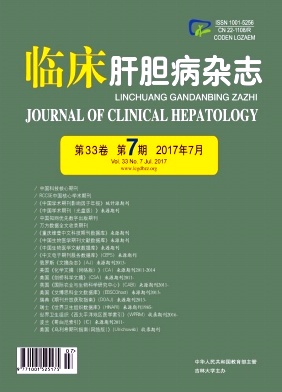|
[1]EL-SERAG HB, RUDOLPH KL.Hepatocellular carcinoma:epidemiology and molecular carcinogenesis[J].Gastroenterology, 2007, 132 (7) :2557-2576.
|
|
[2]BOTA S, PISCAGLIA F, MARINELLI S, et al.Comparison of international guidelines for noninvasive diagnosis of hepatocellular carcinoma[J].Liver Cancer, 2012, 1 (3-4) :190-200.
|
|
[3]European Association for the Study of the Liver, European Organisation for Research and Treatment of Cancer.EASL-EORTC clinical practice guidelines:management of hepatocellular carcinoma[J].J Hepatol, 2012, 56 (4) :908-943.
|
|
[4]LEE JH, LEE JM, KIM SJ, et al.Enhancement patterns of hepatocellular carcinomas on multiphasicmultidetector row CT:comparison with pathological differentiation[J].Br J Radiol, 2012, 85 (1017) :e573-e583.
|
|
[5]NAKANISHI M, CHUMA M, HIGE S, et al.Relationship between diffusion-weighted magnetic resonance imaging and histological tumor grading of hepatocellular carcinoma[J].Ann Surg Oncol, 2012, 19 (4) :1302-1309.
|
|
[6]HEO SH, JEONG YY, SHIN SS, et al.Apparent diffusion coefficient value of diffusion-weighted imaging for hepatocellular carcinoma:correlation with the histologic differentiation and the expression of vascular endothelial growth factor[J].Korean J Radiol, 2010, 11 (3) :295-303.
|
|
[7]NASU K, KUROKI Y, TSUKAMOTO T, et al.Diffusion-weighted imaging of surgically resected hepatocellular carcinoma:imaging characteristics and relationship among signal intensity, apparent diffusion coefficient, and histopathologic grade[J].AJR Am J Roentgenol, 2009, 193 (2) :438-444.
|
|
[8]XU P, ZENG M, LIU K, et al.Microvascular invasion in small hepatocellular carcinoma:is it predictable with preoperative diffusion-weighted imaging?[J].J Gastroenterol Hepatol, 2014, 29 (2) :330-336.
|
|
[9]WOO S, LEE JM, YOON JH, et al.Intravoxel incoherent motion diffusion-weighted MR imaging of hepatocellular carcinoma:correlation with enhancement degree and histologic grade[J].Radiology, 2014, 270 (3) :758-767.
|
|
[10]SCHUHMANN-GIAMPIERI G, SCHMITT-WILLICH H, PRESSWR, et al.Preclinical evaluation of Gd-EOB-DTPA as a contrast agent in MR imaging of the hepatobiliary system[J].Radiology, 1992, 183 (1) :59-64.
|
|
[11]van MONTFOORT JE, STIEGER B, MEIJER DK, et al.Hepatic uptake of the magnetic resonance imaging contrast agent gadoxetate by the organic anion transporting polypeptide Oatp1[J].J Pharmacol Exp T-her, 1999, 290 (1) :153-157.
|
|
[12]LEE YJ, LEE JM, LEE JS, et al.Hepatocellular carcinoma:diagnostic performance of multidetector CT and MR imaging-asystematic review and meta-analysis[J].Radiology, 2015, 275 (1) :97-109.
|
|
[13]KIERANS AS, KANG SK, ROSENKRANTZ AB.The diagnostic performance of dynamic contrast-enhanced MR imaging for detection of small hepatocellular carcinoma measuring up to 2cm:a meta-analysis[J].Radiology, 2016, 278 (1) :82-94.
|
|
[14]ZENG MS, YE HY, GUO L, et al.Gd-EOB-DTPA-enhanced magnetic resonance imaging for focal liver lesions in Chinese patients:a multicenter, open-label, phase III study[J].Hepatobiliary Pancreat Dis Int, 2013, 12 (6) :607-616.
|
|
[15]KUDO M, MATSUI O, SAKAMOTO M, et al.Role of gadolinium-ethoxybenzyl-diethylenetriamine pentaacetic acid-enhanced magnetic resonance imaging in the management of hepatocellular carcinoma:consensus at the Symposium of the 48th Annual Meeting of the Liver Cancer Study Group of Japan[J].Oncology, 2013, 84 (Suppl 1) :21-27.
|
|
[16]Ministry of Health of the People's Republic of China.Diagnosis, management, and treatment of hepatocellular carcinoma (V2011) [J].J Clin Hepatol, 2011, 27 (11) :1141-1158. (in Chinese) 中华人民共和国卫生部.原发性肝癌诊疗规范 (2011年版) [J].临床肝胆病杂志, 2011, 27 (11) :1141-1158.
|
|
[17]YOO SH, CHOI JY, JANG JW, et al.Gd-EOB-DTPA-enhanced MRI is better than MDCT in decision making of curative treatment for hepatocellular carcinoma[J].Ann Surg Oncol, 2013, 20 (9) :2893-2900.
|
|
[18]WANG JH, CHEN TY, OU HY, et al.Clinical impact of gadoxetic acid-enhanced magnetic resonance imaging on hepatoma management:a prospective study[J].Dig Dis Sci, 2016, 61 (4) :1197-1205.
|
|
[19]LEE DH, LEE JM, BAEK JH, et al.Diagnostic performance of gadoxetic acid-enhanced liver MR imaging in the detection of HCCs and allocation of transplant recipients on the basis of the Milan criteria and UNOS guidelines:correlation with histopathologic findings[J].Radiology, 2015, 274 (1) :149-160.
|
|
[20]XIE S, LIU C, YU Z, et al.One-stop-shop preoperative evaluation for living liver donors with gadoxetic acid disodium-enhanced magnetic resonance imaging:efficiency and additional benefit[J].Clin Transplant, 2015, 29 (12) :1164-1172.
|
|
[21]AHN SS, KIM MJ, LIM JS, et al.Added value of gadoxetic acidenhanced hepatobiliary phase MR imaging in the diagnosis of hepatocellular carcinoma[J].Radiology, 2010, 255 (2) :459-466.
|
|
[22]KITAO A, MATSUI O, YONEDA N, et al.The uptake transporter OATP8 expression decreases during multistep hepatocarcinogenesis:correlation with gadoxetic acid enhanced MR imaging[J].Eur Radiol, 2011, 21 (10) :2056-2066.
|
|
[23]ARIIZUMI S, KITAGAWA K, KOTERA Y, et al.A non-smooth tumor margin in the hepatobiliary phase of gadoxetic acid disodium (Gd-EOB-DTPA) -enhanced magnetic resonance imaging predicts microscopic portal vein invasion, intrahepatic metastasis, and early recurrence after hepatectomy in patients with hepatocellular carcinoma[J].J Hepatobiliary Pancreat Sci, 2011, 18 (4) :575-585.
|
|
[24]CHOI JY, LEE JM, SIRLIN C.CT and MR imaging diagnosis and staging of hepatocellular carcinoma:part I.Development, growth, and spread:key pathologic and imaging aspects[J].Radiology, 2014, 272 (3) :635-654.
|
|
[25]WEST CM, Mc KAY MJ, HLSCHER T, et al.Molecular markers predicting radiotherapy response:report and recommendations from an International Atomic Energy Agency technical meeting[J].Int J Radiat Oncol Biol Phys, 2005, 62 (5) :1264-1273.
|
|
[26]YAMASHITA T, KITAO A, MATSUI O, et al.Gd-EOB-DTPA-enhanced magnetic resonance imaging and alpha-fetoprotein predict prognosis of early-stage hepatocellular carcinoma[J].Hepatology, 2014, 60 (5) :1674-1685.
|







 DownLoad:
DownLoad: